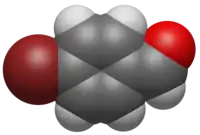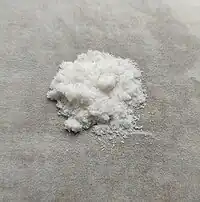 | |
 | |
 | |
| Names | |
|---|---|
| Preferred IUPAC name
4-Bromobenzaldehyde | |
| Other names
p-Bromobenzaldehyde | |
| Identifiers | |
3D model (JSmol) |
|
| ChEMBL | |
| ChemSpider | |
| ECHA InfoCard | 100.013.060 |
| EC Number |
|
PubChem CID |
|
| UNII | |
CompTox Dashboard (EPA) |
|
| |
| |
| Properties | |
| C7H5BrO | |
| Molar mass | 185.020 g·mol−1 |
| Appearance | white solid |
| Odor | almond |
| Melting point | 57 °C (135 °F; 330 K)[1] |
| Boiling point | 255–258 °C (491–496 °F; 528–531 K)[1] |
| Hazards | |
| GHS labelling:[2] | |
  | |
| Danger | |
| H302, H315, H319, H334, H335 | |
| P233, P260, P261, P264, P264+P265, P270, P271, P280, P284, P301+P317, P302+P352, P304+P340, P305+P351+P338, P319, P321, P330, P332+P317, P337+P317, P342+P316, P362+P364, P403, P403+P233, P405, P501 | |
| Related compounds | |
Related compounds |
3-Bromobenzaldehyde |
Except where otherwise noted, data are given for materials in their standard state (at 25 °C [77 °F], 100 kPa).
Infobox references | |
4-Bromobenzaldehyde, or p-bromobenzaldehyde, is an isomer of bromobenzaldehyde.[3]
Preparation
4-Bromobenzaldehyde may be prepared in the laboratory in two steps starting from 4-bromotoluene.[4] In the first step, two bromine atoms are added to the methyl group of 4-bromotoluene by free radical bromination to form 4-bromobenzal bromide. In the second step, the dibrominated methyl group is hydrolyzed with calcium carbonate, then steam distilled to collect 4-bromobenzaldehyde.
Reactions
The bromoaryl group of 4-bromobenzaldehyde may be coupled with trimethylsilylacetylene in a Sonogashira coupling to form 4-((trimethylsilyl)ethynyl)benzaldehyde, followed by removal of the trimethylsilyl group with base to form 4-ethynylbenzaldehyde.[5]
References
- 1 2 "4-Bromobenzaldehyde". ChemSpider. Retrieved 21 October 2023.
- ↑ "4-Bromobenzaldehyde". pubchem.ncbi.nlm.nih.gov.
- ↑ PubChem. "4-Bromobenzaldehyde". pubchem.ncbi.nlm.nih.gov. Retrieved 2023-10-22.
- ↑ Coleman, G. H.; Honeywell, G. E. (1937). "p-BROMOBENZALDEHYDE". Organic Syntheses. 17: 20. doi:10.15227/orgsyn.017.0020.
- ↑ Xu, X.; Cai, P.; Chen, H.; Zhou, H.-C.; Huang, N. (28 September 2022). "Three-Dimensional Covalent Organic Frameworks with she Topology". Journal of the American Chemical Society. 144 (40): 18511–18517. doi:10.1021/jacs.2c07733. PMID 36170014. S2CID 252566430.
This article is issued from Wikipedia. The text is licensed under Creative Commons - Attribution - Sharealike. Additional terms may apply for the media files.